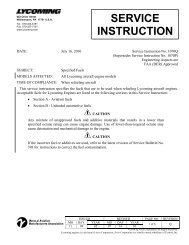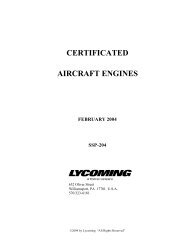Create successful ePaper yourself
Turn your PDF publications into a flip-book with our unique Google optimized e-Paper software.
per hour. Since work is force exerted through a given distance,<br />
it is measured in terms of feet pounds. Thus, on an average, one<br />
horse could do work at the rate of 33,000 feet pounds per minute<br />
or 550 feet pounds per second.<br />
Watt’s definition for one horsepower, which has now become<br />
universal, was, therefore, the doing of work at the rate of 33,000<br />
feet pounds per minute. Today, all conventional power producing<br />
units are rated on this basis.<br />
The 250-horsepower engine in the modern light plane is capable<br />
of doing work at the same rate as that of 250 average horses. From<br />
an interested engineer’s point of view, it is capable of moving<br />
137,500 pounds of weight one foot in one second. Yet, what a difference<br />
there is in its size and weight (approximately 400 pounds)<br />
when compared to the horses it replaces!<br />
CUTAWAY OF A FOUR CYLINDER POWER PLAN<br />
L y c o m i n g F l y e r<br />
The effect the propeller has on engine operation and on aircraft<br />
performance is quite significant. Based on questions which have<br />
been asked by aircraft owners and from experience, there are<br />
several areas of propeller-related information which may be<br />
of interest.<br />
Aircraft equipped with a fixed-pitch propeller will usually have<br />
static RPM (full throttle with aircraft standing still) limitations<br />
and full power in-flight RPM limitations spelled out in the Pilot’s<br />
Operating Handbook. If static RPM is below the minimum specified,<br />
the engine could be low in power. However, experience has<br />
shown that this is not always true. Faulty induction air systems<br />
and/or faulty exhaust systems have been shown to contribute to<br />
indications of low power. A propeller which is ever so slightly<br />
less than perfect may cause the static RPM to be outside the designated<br />
full throttle static RPM zone. In addition to these other<br />
factors, it is not unusual to find a tachometer which is inaccurate.<br />
If an incorrect static RPM reading is observed during the engine<br />
check, any one or all of these components could be at fault.<br />
The tachometer may be the easiest to check as there are hand-held<br />
devices that quickly give an RPM reading that will verify the<br />
accuracy of the standard aircraft instrument. Knowing the accuracy<br />
limits of the aircraft tachometer may eliminate the need for<br />
further examination of the engine and propeller, or it may confirm<br />
the need for further troubleshooting. In any case, consider each<br />
component of the system before blaming low-static RPM reading<br />
on one of them.<br />
Another aspect of operation with a fixed-pitch propeller came in<br />
the form of a question from a <strong>Lycoming</strong> engine owner. He indicated<br />
that the propeller provided by the airframe manufacturer<br />
had been exchanged for a cruise propeller. (This exchange should<br />
only be done with FAA approval.) With the new cruise propeller in<br />
use, an increase in fuel usage was soon apparent. Operating costs<br />
increased, and an explanation was requested.<br />
It is well known that the amount of horsepower taken from an<br />
engine will have a direct relationship to the amount of fuel used.<br />
Therefore, it can be deduced that use of the cruise propeller<br />
increased the horsepower requirement. This deduction deserves<br />
some additional explanation.<br />
As an example, the standard propeller supplied with an aircraft<br />
may allow the engine to develop 180 horsepower at 2700 RPM at<br />
full throttle, in flight at sea level, with a standard temperature. The<br />
<strong>Lycoming</strong> O-360-A Series normally aspirated engine illustrates<br />
this example.<br />
Next, let us assume that this same engine/propeller combination<br />
is operated at 75% power with a “best economy”<br />
fuel/air mixture setting. Again, assume sea level and standard<br />
temperature to simplify and standardize the discussion.<br />
75% power will require about 2450 RPM with a brake-specific<br />
fuel consumption of .435 pounds per brake horsepower<br />
hour. Also, 75% of the 180 rated horsepower is equal to<br />
135 horsepower. Fuel usage at this power and mixture setting<br />
will be 58.7 pounds per hour or 9.8 gallons per hour.







